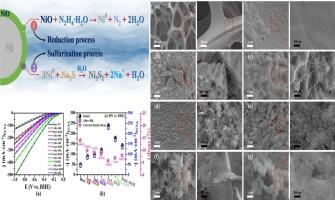Controlled synthesis of Ni3S2 nanostructures on nickel foam for improved HER catalytic performance
IF 6.9
2区 材料科学
Q2 CHEMISTRY, PHYSICAL
引用次数: 0
Abstract
Developing effective, noble metal-free electrocatalysts to improve the slow kinetics of the hydrogen evolution reaction (HER) has garnered significant interest in water electrolysis. In this study, we introduce a one-step, in-situ hydrothermal strategy for precisely fabricating trinickel disulfide (Ni3S2) nanostructures epitaxially grown on nickel foam (NF). Physical characterization revealed that Ni3S2@NF exhibited a range of porous structures, increasing surface area. Additionally, it showed that the quantity of hydrazine hydrate (HZH) plays a crucial role in the reduction and sulfurization processes during Ni3S2 formation on NF, optimizing its catalytic efficiency for HER. The flower-like, porous Ni3S2 clusters provide a variety of catalytically active sites. Due to its uniform and porous morphology, the electrode synthesized with 5 mL HZH (Ni3S2@NF/5mL-HZH) exhibited the highest electrochemical surface area (ECSA) and optimal catalytic performance. This result in the lowest overpotential (46.8 mV at 10 mA·cm–2), charge transfer resistance (Rct = 2.74 Ω), and HER kinetics (Tafel slope: 62.3 mV·dec–1), surpassing previously reported Ni3S2-based HER catalysts. Furthermore, prolonged durability testing exhibited a slight current decline after 48 h of continuous operation. This study highlights the significant influence of ZHZ concentration on the morphology and electrochemical properties of Ni3S2@NF, emphasizing its potential as a promising candidate for sustainable hydrogen production in energy applications.

在泡沫镍上可控合成Ni3S2纳米结构以提高HER催化性能
开发有效的、无贵金属的电催化剂来改善析氢反应的缓慢动力学已经引起了人们对水电解的极大兴趣。在这项研究中,我们介绍了一种一步原位水热策略,用于精确制备在泡沫镍(NF)上外延生长的二硫化镍(Ni3S2)纳米结构。物理表征表明Ni3S2@NF呈现出一系列多孔结构,增加了表面积。结果表明,水合肼(hydrazine hydrate, HZH)的用量对Ni3S2在NF上的还原和硫化过程起着至关重要的作用,从而优化了其对HER的催化效率。花状多孔Ni3S2簇提供了多种催化活性位点。5 mL HZH (Ni3S2@NF/5mL-HZH)的电极形貌均匀且多孔,具有最高的电化学表面积(ECSA)和最佳的催化性能。结果表明,该催化剂的过电位最低(10 mA·cm-2时46.8 mV),电荷转移电阻最低(Rct = 2.74 Ω), HER动力学最低(Tafel斜率:62.3 mV·dec1),超过了先前报道的基于ni3s2的HER催化剂。此外,延长耐久性测试显示,在连续运行48 h后,电流略有下降。本研究强调了ZHZ浓度对Ni3S2@NF形貌和电化学性能的显著影响,强调了其作为能源应用中可持续制氢的有前途的候选物的潜力。
本文章由计算机程序翻译,如有差异,请以英文原文为准。
求助全文
约1分钟内获得全文
求助全文
来源期刊

Applied Surface Science
工程技术-材料科学:膜
CiteScore
12.50
自引率
7.50%
发文量
3393
审稿时长
67 days
期刊介绍:
Applied Surface Science covers topics contributing to a better understanding of surfaces, interfaces, nanostructures and their applications. The journal is concerned with scientific research on the atomic and molecular level of material properties determined with specific surface analytical techniques and/or computational methods, as well as the processing of such structures.
 求助内容:
求助内容: 应助结果提醒方式:
应助结果提醒方式:


